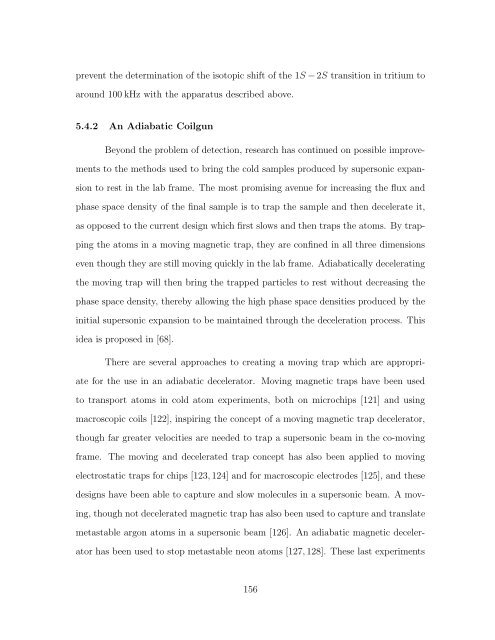Experiments with Supersonic Beams as a Source of Cold Atoms
Experiments with Supersonic Beams as a Source of Cold Atoms
Experiments with Supersonic Beams as a Source of Cold Atoms
Create successful ePaper yourself
Turn your PDF publications into a flip-book with our unique Google optimized e-Paper software.
prevent the determination <strong>of</strong> the isotopic shift <strong>of</strong> the 1S − 2S transition in tritium to<br />
around 100 kHz <strong>with</strong> the apparatus described above.<br />
5.4.2 An Adiabatic Coilgun<br />
Beyond the problem <strong>of</strong> detection, research h<strong>as</strong> continued on possible improve-<br />
ments to the methods used to bring the cold samples produced by supersonic expan-<br />
sion to rest in the lab frame. The most promising avenue for incre<strong>as</strong>ing the flux and<br />
ph<strong>as</strong>e space density <strong>of</strong> the final sample is to trap the sample and then decelerate it,<br />
<strong>as</strong> opposed to the current design which first slows and then traps the atoms. By trap-<br />
ping the atoms in a moving magnetic trap, they are confined in all three dimensions<br />
even though they are still moving quickly in the lab frame. Adiabatically decelerating<br />
the moving trap will then bring the trapped particles to rest <strong>with</strong>out decre<strong>as</strong>ing the<br />
ph<strong>as</strong>e space density, thereby allowing the high ph<strong>as</strong>e space densities produced by the<br />
initial supersonic expansion to be maintained through the deceleration process. This<br />
idea is proposed in [68].<br />
There are several approaches to creating a moving trap which are appropri-<br />
ate for the use in an adiabatic decelerator. Moving magnetic traps have been used<br />
to transport atoms in cold atom experiments, both on microchips [121] and using<br />
macroscopic coils [122], inspiring the concept <strong>of</strong> a moving magnetic trap decelerator,<br />
though far greater velocities are needed to trap a supersonic beam in the co-moving<br />
frame. The moving and decelerated trap concept h<strong>as</strong> also been applied to moving<br />
electrostatic traps for chips [123, 124] and for macroscopic electrodes [125], and these<br />
designs have been able to capture and slow molecules in a supersonic beam. A mov-<br />
ing, though not decelerated magnetic trap h<strong>as</strong> also been used to capture and translate<br />
met<strong>as</strong>table argon atoms in a supersonic beam [126]. An adiabatic magnetic deceler-<br />
ator h<strong>as</strong> been used to stop met<strong>as</strong>table neon atoms [127, 128]. These l<strong>as</strong>t experiments<br />
156
















